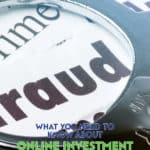What You Need to Know about Online Investment Fraud

Gold flees the man who would force it to impossible earnings or who followeth the alluring advice of tricksters and schemers or who trusts it to his own inexperience and romantic desires in investment.
~ The Five Laws of Gold (#5), The Richest Man in Babylon by George S. Clason
March is Fraud Prevention Month and the CSA (Canadian Securities Administrators) have been busy with a unique campaign designed to show investors how easy it can be to fall victim to fraud – especially in the Internet Age. I have to admit that I don’t think about investment fraud that often since I manage all of our money myself. I sometimes forget that this is not the case for the majority of Canadians.
In the era of 1% interest rates and volatile markets, investors might be forgiven for reaching for a few extra percentage points of return. Still, stepping outside of the regulated investment arena can be extremely risky. Indeed, you might not even realize you’ve done it. Let’s take a look at what CSA has done for this campaign.
BlueHedge Investments
Phase one of the CSA fraud awareness campaign involved setting up a very professional-looking website for a fictional investment company called BlueHedge Investments. It basically simulates a fraudulent company’s website, complete with claims like this:
“BlueHedge Investments ensures the success of our future generations while helping build the financial stability of our people today. Furthering green energy and resource allocation – fuelling environmental, sustainable and future energy and resources.
- Earn 9% interest per month
- Invest with professional market leaders
- Earn money risk free!”
The Alberta Securities Commission reported the following results:
“During the 10-week campaign, the BlueHedge website received almost 18,000 visits from across Canada with 71 per cent of those arriving to the site because they clicked on online ads, many of which were featured on popular search engine sites. As well, regulators found that more than 10 per cent of those who received unsolicited emails from BlueHedge opened the emails, and of those, almost 13 per cent clicked on the provided BlueHedge links.”
BlueHedge isn’t Real
Visitors who clicked through to invest were taken to an educational website called bluehedgeisntreal.ca. There’s some great information there, including some red flags to watch for:
- Guaranteed high returns, no risk
- High pressure sales tactics to invest right away
- Tax-free and offshore
- Slick appearances that don’t measure up
- Lack of quality information: long on buzzwords and short on details
There’s also a section on All You Need to Know in Under 5 Minutes:
- Know your goals.
- Know who you’re dealing with.
- Know your investments.
- Know the red flags of fraud.
- Know where to go for help.
A Little Common Sense Goes a Long Way
You don’t have to be on the left end of the IQ curve to become a victim of fraud. In fact, you can see that some of the claims on the fraudulent site might appeal to more sophisticated investors, or those looking to move into the big leagues to reach for better returns. Still, the old saying about things that look too good to be true is probably a pretty good guidepost.
For our own investing, I try to make sure we hold our cash in CDIC insured financial institutions and our investments at IIROC and CIPF members. In the unlikely event that we were to ever invest in something outside of these regulated entities, I’m certain we’d make sure we didn’t invest enough of our capital to do any serious harm in the event of a 100% loss. No amount of money is worth the risk.
Have you taken any steps to ensure you and your hard-earned savings don’t succumb to investment fraud? What did you think of the BlueHedge campaign?


Comments
Hi 2-cents….
great post and I love the idea of BlueHedge. In fact, I’m going to add a link to this in my related and latest:
http://jlcollinsnh.wordpress.com/2012/03/09/you-too-can-be-conned/
Cheers,
JC
Thanks very much for highlighting this issue! 🙂
What a fascinating technique. Sad to think that so many were enticed by easy riches. I guess not everyone subscribes to the saying, “if it sounds too good to be true…”
I guess higher returns look pretty enticing in a world where interest rates are below 2% and financial markets are extremely volatile. I was amazed at how professional the site looked and the fact that they actually guaranteed the “no-risk” returns. I would imagine it’s difficult for regulators to police the internet when just about anyone can quickly and easily set up a website.
Thanks for your comments!
I really like what you have posted here, many people don’t understand or are unaware of the dangers associated with online investment companies. I was definitely one of them, until I read this post. I really like how you gave a brief, yet detailed instance from the CSA and how we can avoid falling to these traps by showing us red flags to look out for. Definitely a very vital issue, and a very good post about it. Always remember, “if it looks too good to be true,” it probably is!
Amazing Work!